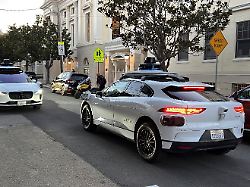Years of delay
When cars will drive autonomously through Germany
By Christina Lohner
January 21, 2024, 11:58 a.m
Listen to article
This audio version was artificially generated. More info | Send feedback
Bosch is cutting more than 1,000 jobs because the development of automated driving is costing the industry more time than expected. According to industry expert Stefan Bratzel, the reason is a huge data gap. The year 2030 is likely to be a turning point.
In addition to cutting jobs in its drive division, Bosch now also wants to cut around 1,200 jobs in the software area because the challenges of automated driving are greater than expected. Autonomous driving continues to be one of the key innovations for the German auto industry to remain competitive, but development is taking significantly longer than forecast – the introduction has been delayed by years. Industry expert Stefan Bratzel does not expect widespread use of driverless robotaxis in major German cities such as Hamburg, Munich and Berlin until 2030. as he explains in an interview with ntv.de.
From 2030 The head of the Center of Automotive Management at the University of Applied Sciences in Bergisch Gladbach expects cars to travel independently at over 100 kilometers per hour. Private owners could then use the motorway journey for other things, such as writing emails or reading and watching the latest news. At the beginning of the 2030s, the hardware costs for sensors should fall so much that although a few thousand euros will still be required, the technology will no longer only be installed in the luxury class, but in broader vehicle segments, Bratzel expects.
It will probably be another few years before self-driving private cars are widely used in city traffic. At the moment, premium models from Mercedes and BMW are able to drive autonomously on the motorway at speeds of up to 60 km/h under certain conditions, i.e. as a traffic jam pilot. If the tracks are easy to see and are free of roadworks, the car tells the driver that they can take their hands off the steering wheel and do something else. However, the human must be able to take control again within ten seconds.
Devastating accident for GM subsidiary
The manufacturers now assume liability for these cases. “A huge step,” emphasizes Bratzel. Even at low speeds, a car can travel a distance in ten seconds. Customers currently have to pay 6,000 to 8,000 euros for such a traffic jam pilot – a lot of money for rare applications. The customer base is therefore still manageable.
However, costs are not the biggest brake on autonomous driving. According to Bratzel, the manufacturers are still missing gigantic amounts of data. Because safety is the be-all and end-all here. “The manufacturers have to statistically prove that they are better than human drivers.” In order to be much better than humans, a fatal accident with autonomous vehicles should only happen every ten million kilometers. To do this, you have to test 100 million kilometers in real and virtual simulations in order to detect even rare safety risks.
The GM subsidiary Cruise, which had to stop operations in San Francisco after an accident with one of its robot taxis, failed in this regard. A pedestrian was hit by another car and thrown in front of the self-driving car. The latter braked immediately, but dragged the woman as it drove to the side of the road. “There was no data for this terrible case,” says Bratzel.
There will be no autonomous driving without fatalities
Added to this is social acceptance – how much risk do we want to take? “There will be no autonomous driving and zero traffic fatalities,” the expert makes clear. However, the number of traffic accidents could be significantly reduced by self-driving cars. Another advantage: The technology can compensate for the growing shortage of drivers for trucks and buses in the long term, even if safety drivers are currently still on board during test drives in the USA. Such journeys are also likely to become cheaper, including in passenger transport, at least compared to taxi journeys today.
Tesla actually wanted to be ready for its autopilot to steer fully autonomously through traffic, but Bratzel believes that would still take a few years. In his opinion, Elon Musk failed primarily because he only relied on camera technology for sensor technology for cost reasons. Other manufacturers added radar and WiFi for security reasons.
Even though Tesla has now been caught up, “music and progress play in the USA and China,” says Bratzel. In addition to Tesla, Mercedes and BMW are at the forefront of privately owned cars, which now enable the driver to at least temporarily pursue another activity – he or she no longer has to constantly monitor the system. According to Bratzel, the three manufacturers are followed by GM and Ford as well as Xpeng from China.
When it comes to robotaxis, the Germans are behind
But when it comes to robot taxis, “German manufacturers are lagging behind”. This is where Waymo leads, whose driverless taxis are already rolling through San Francisco. After Cruise had to end this, Bratzel only sees Baidu from China in the front row. In the second tier are mainly Chinese providers such as AutoX and Pony.ai.
Of the German manufacturers, only VW is trying this area, although the Lower Saxony company is using the technology of its Israeli partner Mobileye. The test phase in Hamburg is scheduled to start in 2026 at the latest. Bratzel warns: “We actually have to get past these pilot phases.”
